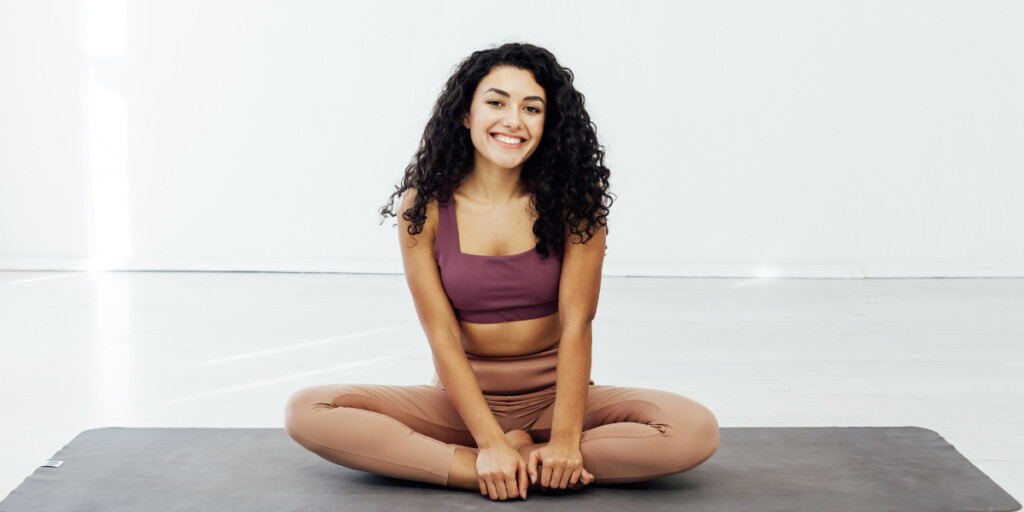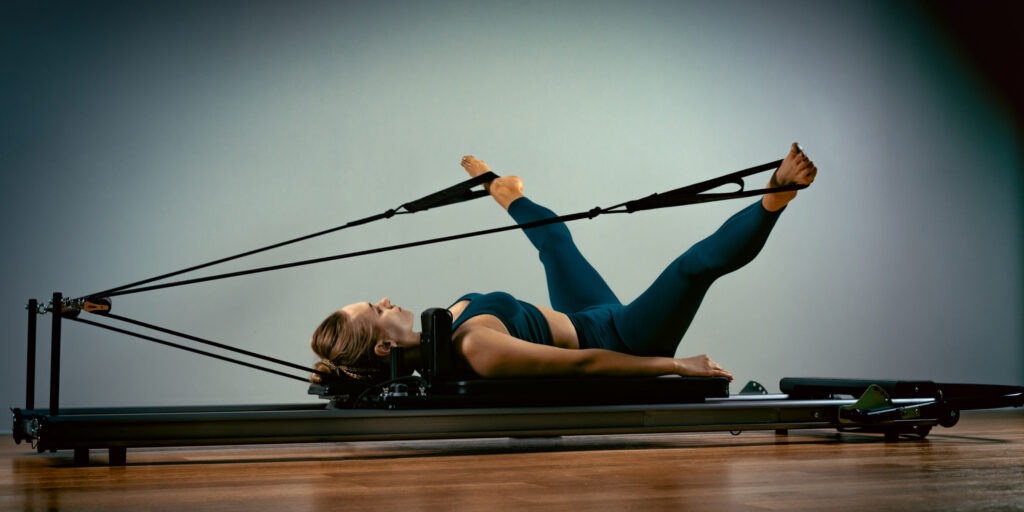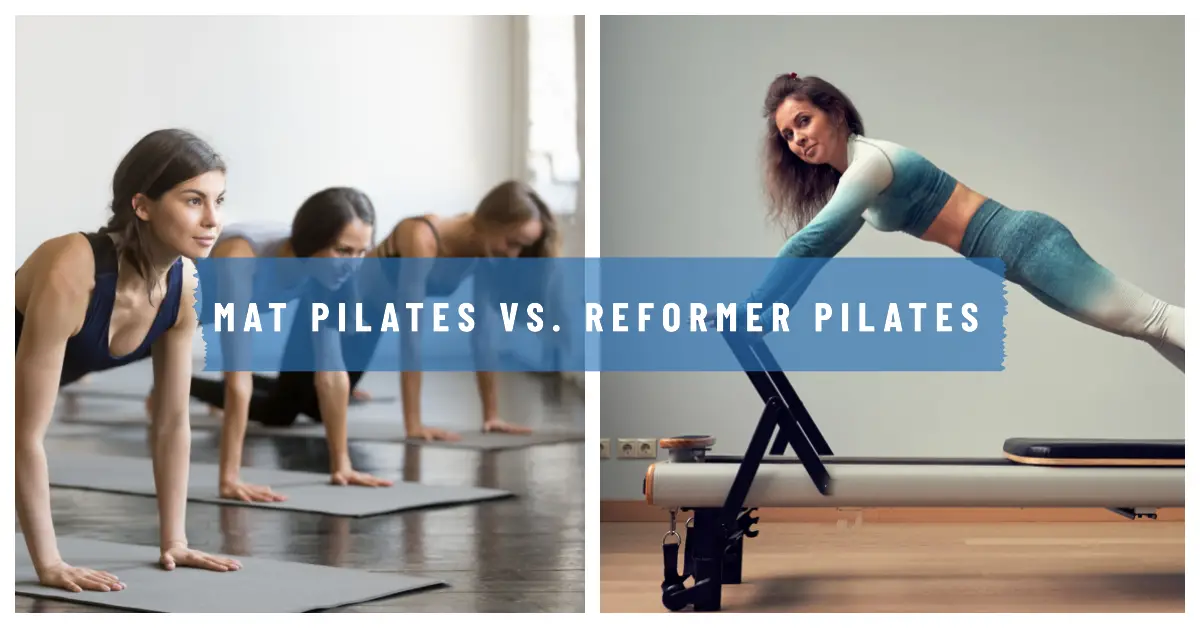In the realm of physical conditioning and mindful movement, Pilates has emerged as a powerhouse. From its humble beginnings in the early 20th century, the discipline has branched out into various styles, two of the most popular being Mat and Reformer Pilates. Distinguished by unique methods, tools, and outcomes, each approach provides a diverse experience. Whether you’re seeking to enhance flexibility, boost strength, or cultivate an improved sense of body awareness, there’s a style tailored to your needs.
Mat Pilates is great for beginners and those focusing on core strength and flexibility. Reformer Pilates, while more equipment-intensive, offers a more dynamic, full-body workout and resistance training. The choice between Mat and Reformer Pilates depends on your goals and preferences.
This article offers a deeper dive into these two types of Pilates to aid you in uncovering which might be the ideal choice for your wellness journey.
Mat Pilates: The Foundation of Mind-Body Balance
As the name suggests, Mat Pilates is performed on a mat and uses your body weight for resistance. It’s the original form of Pilates, developed by Joseph Pilates during World War I to improve physical strength and endurance. Characterized by its focus on mindful, controlled movements and breath work, Mat Pilates lays a robust foundation for a strong mind-body connection. It’s a discipline that teaches you to move with precision, harnessing inner strength and promoting better posture.
The exercises in Mat Pilates primarily engage your ‘powerhouse,’ a term used in Pilates that encompasses your abs, lower back, hips, and glutes. The sequences are designed to strengthen these core muscles, providing stability and support for your entire body. Yet, despite this core focus, the practice also promotes overall body strength and flexibility. Mat Pilates exercises to challenge your muscles to resist gravity and the weight of your body, thus improving overall body strength in a balanced and harmonious way.

While Mat Pilates is often associated with a slower pace and lower intensity, this isn’t an easy workout. The exercises require great focus, concentration, and control over the smallest movements. Each carefully crafted pose and sequence is designed to challenge your balance, coordination, and stability. This can make even the most seasoned fitness enthusiasts break into a sweat. At the same time, the emphasis on breath work and smooth transitions between poses imbue the practice with a sense of calm and mindfulness, solidifying Mat Pilates as a perfect blend of physical challenge and mental tranquillity.
The Benefits of Mat Pilates
Physical Benefits:
- Develops a strong core: Mat Pilates exercises heavily on the ‘powerhouse’ muscles – the abs, lower back, hips, and glutes, contributing to a stronger core essential for maintaining proper posture and preventing back pain.
- Improves flexibility: Mat Pilates gradually stretches and lengthens the muscles through its gentle yet precise movements, aiding in increased flexibility.
- Enhances body awareness: Focusing on controlled movements enhances body awareness, helping individuals develop better movement patterns and balance.
- Adaptable to all fitness levels: Mat Pilates exercises can be modified to match an individual’s fitness level, making it an inclusive practice that beginners and advanced practitioners alike can enjoy.
Mental Benefits:
- Stress relief: Mat Pilates, emphasizing mindful movement and synchronizing breath with movement, introduces a meditative aspect to the workout, helping to relieve stress.
- Improves focus: As the practice demands concentration on each movement, it can enhance focus and attention, useful skills that transfer beyond the mat.
- Boosts mood and mental health: The tranquility achieved through Mat Pilates can positively affect mood and overall mental health.
Reformer Pilates: A Whole New Level of Challenge
Reformer Pilates takes the fundamental principles of traditional Mat Pilates and introduces an entirely new level of a challenge using a unique piece of equipment known as the reformer. This device, first designed by Joseph Pilates himself, is a sophisticated apparatus equipped with a flat platform, called a carriage, that moves back and forth within a frame. The carriage is connected to springs that provide varying resistance levels as exercises are performed.
Unlike Mat Pilates, which primarily relies on your body weight for resistance, Reformer Pilates capitalizes on the reformer’s adjustable resistance system. This feature allows for more varied, dynamic, and intense exercises while maintaining Pilates’ characteristic control and precision. Reformer Pilates emphasizes full-body integration, targeting the core, arms, and legs in various movements.

The reformer is designed to challenge your body in multiple planes of motion, providing a comprehensive workout that can significantly improve strength, flexibility, and coordination. The exercises performed on the reformer range from gentle and restorative movements to high-intensity sequences that can raise the heart rate and provide a robust cardiovascular workout.
This versatility and the inherent challenge of working against the reformer’s resistance make Reformer Pilates a powerful tool for elevating your fitness level and enhancing your overall physical health.
The Benefits of Reformer Pilates
Physical Benefits:
- Provides a full-body workout: Unlike Mat Pilates which focuses primarily on the core, Reformer Pilates targets the whole body, including the arms and legs, ensuring a balanced and comprehensive workout.
- Enhanced strength and muscle tone: Thanks to the adjustable resistance of the reformer, Reformer Pilates offers increased strength training, leading to improved muscle tone and definition.
- Increases flexibility: The reformer’s design enables a wide range of movements, which can aid in improving overall body flexibility.
- Cardiovascular benefits: Some Reformer Pilates exercises are performed at a pace that can elevate the heart rate, offering cardiovascular benefits in addition to strength training.
Mental Benefits:
- Improves concentration: Much like Mat Pilates, the precise and controlled movements required in Reformer Pilates can enhance focus and concentration.
- Promotes body awareness: By challenging the body in different planes of motion, Reformer Pilates increases body awareness, improving movement patterns and coordination.
- Stress relief: Despite its intensity, Reformer Pilates can also offer stress-relieving benefits due to its focus on controlled breathing and mindful movements.
Comparing Mat and Reformer Pilates: Costs, Accessibility, and Equipment
Regarding cost, accessibility, and equipment, there are distinct differences between Mat and Reformer Pilates that are important to consider.
Cost
- Mat Pilates: Mat Pilates classes are generally less expensive than their Reformer counterparts. Further, practicing Mat Pilates at home requires little to no cost, as you only need a mat and enough space to move.
- Reformer Pilates: Classes for Reformer Pilates tend to be more expensive due to the specialized equipment and often smaller class sizes. If you’re considering purchasing a home-use reformer, be prepared for a significant investment.
Accessibility
- Mat Pilates: This form of Pilates is highly accessible. Classes are widely available at most fitness centers and yoga studios, and you can also find many online classes for home practice.
- Reformer Pilates: While growing in popularity, Reformer Pilates is not as readily accessible as Mat Pilates. The equipment needed for these classes is typically only found in specialized Pilates studios or high-end fitness centers.
Equipment
- Mat Pilates: The main equipment needed is a Pilates mat. Some classes may also incorporate small equipment such as Pilates rings, resistance bands, or small weights, but these are typically optional.
- Reformer Pilates: A reformer machine is required for these exercises. The reformer includes a moving carriage, straps, and adjustable springs. Other pieces of equipment, such as a Pilates box or pole, may also be used in some classes.
What to Expect in a Mat Pilates Class
Stepping into a Mat Pilates class, you can expect a welcoming and calm environment focusing on mindful movement. Here’s a closer look at what you might encounter:
The Setup: A typical Mat Pilates class starts with each participant setting up their space with a Pilates mat. Some classes may provide mats, but you might need to bring your own in others. You might also find additional equipment like resistance bands, small weights, or Pilates rings being used, but these are not essential to every class.
The Warm-up: Classes usually begin with a series of gentle exercises to warm up the body and introduce the principles of Pilates, such as focusing on breath, alignment, and controlled movement.
The Workout: The main part of the class involves various exercises performed on the mat. These exercises primarily target the core (or ‘powerhouse’) but also work on the rest of the body, promoting strength, flexibility, and balance. You’ll perform each movement with careful attention to form and alignment under the guidance of your instructor.
The Pace: Mat Pilates exercises are often slow and controlled, requiring concentration and precision. However, don’t let the slower pace fool you – these exercises can be challenging!
The Cool Down: The class typically concludes with a cool-down period, which involves gentle stretches and relaxation to help your body recover and to promote flexibility.
The Environment: A Mat Pilates class is typically calm and serene, often accompanied by soft, soothing music. This supportive and non-competitive atmosphere lets you focus on progress and body awareness.
Remember, every Mat Pilates class can be slightly different, depending on the instructor and the class level. Beginners are often encouraged to start with a basic class to learn the foundational movements before moving on to more advanced levels.
What to Expect in a Reformer Pilates Class
Entering a Reformer Pilates class, you’ll encounter a unique environment with specialized equipment. Here’s a glimpse into what to expect:
The Setup: In a Reformer Pilates class, each participant gets a reformer machine. The reformer consists of a flat platform called the carriage, which moves back and forth within a frame, connected by springs that offer varying resistance levels. Additional equipment like a Pilates box or pole may also be incorporated.
The Introduction: If you’re new to Reformer Pilates, the instructor will likely start by explaining how the reformer works and demonstrating how to adjust the machine to suit your needs and ability level.
The Warm-up: Similar to a Mat Pilates class, a Reformer class will start with a series of warm-up exercises. These are designed to introduce Pilates’ principles and familiarize you with the reformer.
The Workout: The bulk of the class will be spent performing various exercises on the reformer. These exercises target the entire body and offer a dynamic and versatile workout. The movements range from gentle, lengthening stretches to strength-based exercises and sometimes even cardio.
The Pace: The pace of a Reformer Pilates class can vary. Some exercises might be slow and controlled, emphasizing precision and alignment, while others may be faster, designed to elevate your heart rate and challenge your coordination.
The Cool Down: As with Mat Pilates, classes typically conclude with a cool-down period of gentle stretches and relaxation.
The Environment: The environment in a Reformer Pilates class is supportive and focused. Given the complexity of the equipment, class sizes tend to be smaller, allowing for more personalized attention from the instructor.
Reformer Pilates classes cater to different levels, from beginner to advanced. If you’re a beginner, starting with a basic class or a one-on-one session could be beneficial to learn the ropes before diving into more advanced classes.
Choosing the Right Style for You: Personal Goals and Preferences
When selecting the right Pilates style, your personal goals and preferences play a significant role. Are you looking for a practice you can do at home without needing much equipment? Mat Pilates might be your perfect fit. Do you seek a comprehensive workout that simultaneously challenges your strength, flexibility, and cardiovascular fitness? Reformer Pilates could be just what you need. Here are some aspects to consider when making your choice:
Fitness Goals: Are you aiming to build a stronger core, enhance your flexibility, and improve your balance? Both Mat and Reformer Pilates can help you achieve these goals. However, if you’re looking for a more intense, full-body workout offering more resistance and strength training, Reformer Pilates could align more with your objectives.
Budget and Accessibility: Mat Pilates tends to be more cost-effective, requiring minimal equipment and typically lower class fees. It’s also highly accessible, with numerous online resources available for practicing at home. Reformer Pilates, on the other hand, while more expensive due to the specialized equipment and often smaller class sizes, can offer a dynamic and varied workout experience that some find worth the investment.
Personal Preferences: Do you prefer a slow, controlled pace focusing on precise movements and breath control? Mat Pilates offers a serene and meditative practice. Reformer Pilates might be more engaging if you’re drawn towards versatile exercises with an adjustable resistance system and enjoy working with innovative equipment.
Health Considerations: If you’re recovering from an injury or have certain health conditions, one form of Pilates may be more suitable. It’s crucial to consult with a healthcare professional before starting any new fitness routine.
Ultimately, the choice between Mat and Reformer Pilates isn’t necessarily an either-or decision. Many practitioners enjoy and benefit from incorporating both styles into their fitness regimes. Explore both options if possible, and find the balance that suits your lifestyle, fulfills your fitness goals, and, most importantly, brings you joy.
Sources:
https://www.shape.com/mat-pilates-vs-reformer-pilates-6754499
https://www.gaiam.com/blogs/discover/should-you-do-pilates-on-a-mat-or-on-a-reformer




